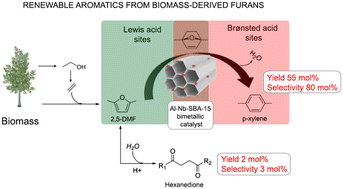From biomass-derived furans to aromatic compounds: design of Al–Nb-SBA-15 mesoporous structures and study of their acid properties on catalytic performance†
Abstract
Renewable aromatics compounds (i.e. BTXs) are interesting, useful and much desired chemicals for industry due to the lack or difficulty to find available non-fossil feedstocks capable to produce these aromatics in good yields. Therefore, the aromatization reaction of biomass-derived furans is a valuable strategy for a sustainable production of aromatic compounds. In this work, modified SBA-15 mesoporous silicates with enhanced acid properties were successfully synthetized by a one-pot method, directly incorporating the metal precursor (Nb, W, Ga, Zr, Al) in the synthesis gel. The solids were characterized by different techniques, such as XRD, TEM, ICP, N2 physisorption, FT-IR of adsorbed pyridine and NH3-TPD, among others. The catalytic performance of mesoporous materials was tested in the Diels–Alder (DA) aromatization reaction using 2,5-DMF as a diene and ethylene as a dienophile for the selective production of p-xylene (p-xy). Among the mono-metallic solids (modified with Nb, W, Ga, Zr or Al) showing Lewis (Le) acidity, only those that also present Brønsted (Br) sites showed activity in the aromatization reaction, appearing Al(x)–S as the most selective catalyst for the p-xy production. Then, Br acidity in bi-metallic solids was ensured by co-incorporating Al in the structure, showing Al–Nb-SBA-15 – materials the best catalytic performance. For these solids, the p-xy yield showed a strong dependence with the metal content and the moderate strength Br/Le acid sites ratio. Optimization of the composition of Al–Nb-SBA-15 catalyst and the reaction conditions allowed reaching a p-xy yield even higher than that observed for previous reported reference catalyst (i.e. H-ZSM-5). It was demonstrated that the type of metals (Al and Nb) incorporated in SBA-15 provides an adequate combination of Br and Le acid sites of moderate strength and homogeneously distributed on the solid (low surface density of acid sites), which together with the high accessibility offered by the mesoporous material, are features to be considered for the aromatic production. The observed activity for catalysts with both Le and Br sites was mainly attributed to their ability to retard side reactions, such as oligomerization and alkylation by means of the effective cycloaddition of 2,5-DMF with ethylene in Le sites, in addition to the dehydrative aromatization reaction allowed by the presence of Br acidity.



 Please wait while we load your content...
Please wait while we load your content...